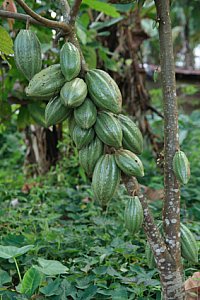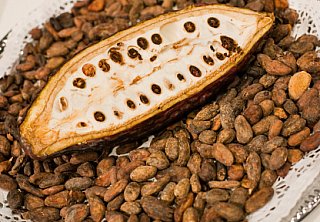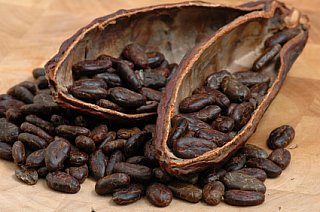Did you know that chocolate actually comes from trees? It's true! This small tree is called Theobroma cacao, or the cocoa tree. Its fruit produces cocoa seeds, from which cocoa powder and chocolate are made. If only chocolate bars grew on trees!
If you're a chocoholic, then you have two more chocolate days to celebrate! World Chocolate Day is on September 4 and National Chocolate Day is on October 28.
Today, take the time to enjoy this favorite treat. Whether it’s in the form of a bar, syrup or ice cream—the choice is yours! Today is also National Strawberry Sundae Day so maybe you pour the chocolate all over your sundae :) Oh yeah - JULY is also National Ice Cream Month!!!
If you ever wondered how is chocolate made or where does chocolate come from, then this page will help you discover the answers plus share a few chocolate facts and easy chocolate recipes.
The information below is brought to you by http://www.kids-cooking-activities.com
How Chocolate is Made
Where does chocolate come from?
To learn how is chocolate made first, you'll never believe what the chocolate that we enjoy today looks like from the beginning. It all begins south of the equator in large pods that grow on the cacao tree.From the halls of Montezuma Ancient Mesoamerican civilizations used to give the cacao tree an important place in society. The Mayans and the Aztecs used to use cocoa beans as currency. Crushed cocoa beans were used to make a bitter liquid called xocoatl. Only royalty and the best military warriors could gain access to the drink. It wasn’t until European settlers came to South America and Africa that the cocoa bean made its way to the modern world.
Even though that was a few hundred years ago, the process of prepping the cocoa bean for chocolate manufacturing remains pretty much the same. Cacao trees produce large fruit pods on the trunk of the tree. The pods are harvested with machetes. When you crack them open, you’ll find about fifty or more seeds within a sweet pulp.

 How is chocolate made starts with these cocoa beans inside a cocoa fruit.
How is chocolate made starts with these cocoa beans inside a cocoa fruit.How is chocolate made from cocoa beans?
The pulp and the cocoa beans are removed and placed in buckets for fermentation. Depending on the type of cacao tree and the manufacturer, the process can take a week or longer.Fermentation gives the beans some semblance of the chocolate taste we like. Once the fermentation process is complete, the cocoa beans are spread out so that they can dry naturally in the sun.
It is the dried beans that are shipped to chocolate manufacturers all over the world. Once there, the beans are roasted, much like coffee beans. Roasting intensifies the final taste of the chocolate. When the beans are ready, the shells are then removed. What you are left with is the essence of the bean – cocoa butter and other chocolate solids. Now, how is chocolate made from this, read on.

Even though some of the ingredients are trade secrets, the process is quite similar. The chocolate paste goes through a machine that removes the cocoa butter. This leaves you with a powdery cocoa. Substances like cocoa butter (re-added), sugar, milk, oil and the like are added to reconstitute the powder into chocolate. The last step in chocolate making is conching.
The chocolate is mixed in a large machine until it is the consistency the manufacturer likes. After, the chocolate is poured into molds, allowed to cool, wrapped up and then packaged for shipment.
How is Chocolate Made from Cocoa Beans Video
Chocolate in many shapes and sizes
- Semisweet morsels –These are perfect for chocolate chip cookies or any type of add ins in baking.
- Semisweet chocolate bricks – This is baking chocolate. It can be cut up and melted for chocolate candy, chocolate cakes and icings.
- Unsweetened dark chocolate bars – Unsweetened chocolate is used for recipes that call for other sweet ingredients like sugar or honey to offset the bitter taste. Many unsweetened dark chocolate bars don’t contain anything but cocoa solids so they are safe for those with food allergies.
- Dark chocolate or milk chocolate bars – With or without the nuts or fruit pieces, these are great for eating. Milk chocolate is creamy but the added milk also adds calories and fat. Depending on the chocolate manufacturer, you may get a different taste with each brand you try.
- Cocoa powder – This is where the chocolate begins as a presscake once the cocoa butter is removed. The presscake can then be packaged as cocoa powder for hot chocolate and also for baking. Unsweetened baking cocoa is best for recipes. Hot chocolate has other dried ingredients added like sugar and dehydrated marshmallows. It is just for drinking.
Easy Chocolate Recipes
Now that we've answered the question, how is chocolate made, create some easy chocolate recipes.Step by Step demonstration on how to make Chocolate from Cocoa Beans:
http://www.wikihow.com/Make-Chocolate
Making Chocolate from Cocoa Powder:
or
Making Chocolate Video:
This is the list of ingredients used in the above video:
Ingredients:
125g vegetable shortening (Copha or solidified coconut oil works fine)
125g confectioner's sugar (pure icing sugar)
6 tablespoons cocoa powder (good quality)
4 tablespoons powdered milk (full cream)
Pinch of salt
125g vegetable shortening (Copha or solidified coconut oil works fine)
125g confectioner's sugar (pure icing sugar)
6 tablespoons cocoa powder (good quality)
4 tablespoons powdered milk (full cream)
Pinch of salt
Chocolate Educational Resources:
All these incredible lesson plans and resources below are from - http://www.fmnh.org/chocolate/
| Cocoa Connections: From Beans to Bars - A Resource Kit for Educators contains 12 lessons—six lessons on chocolate and the environment and six lessons on chocolate and culture—that will increase your students’ understanding of the connections between humans and their environment. Each lesson outlines learning objectives, a list of materials needed, and instructional activities. The full curriculum also includes extension activities, an overview of the Chocolate exhibition, a suggested reading and film list, and classroom-friendly recipes. Student activity sheets for each unit are provided in both English and Spanish. A hard copy of the curriculum is also available when you borrow The Story of Chocolate exhibit case from Harris Loan center. For more information on this case, download the Resources for Educators section listed below or call 312.665.7555 to speak with the registrar. Using chocolate as a framework, students can:
Download Introduction:
Download Chocolate and its Environment lessons:
Download Chocolate and Culture lessons:
Download Resource Materials: |
|
FREE printable worksheets and coloring pages - http://www.abcteach.com/directory/theme_units/chocolate/



Hi,
ReplyDeleteI appreciate that you enjoyed reading our Kids Cooking Activities site, however Copyscape has informed us that your website is plagiarizing. We insist you take our information that has been copied word for word including all of our pictures off the pages!
Thank you for your understanding.
Debbie Madson